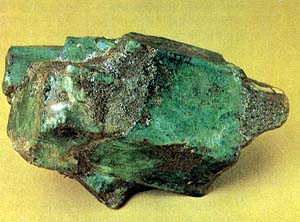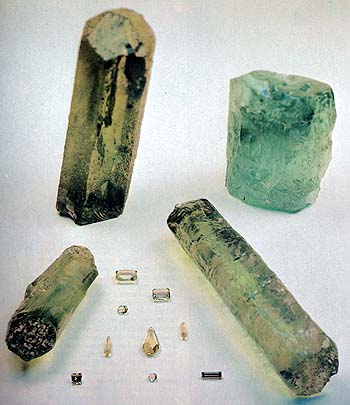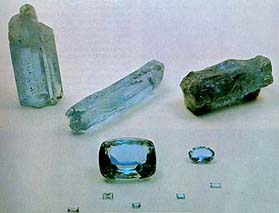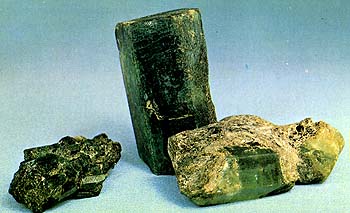Beryl (group of beryl) - heliodores, emeralds, aquamarines, morganites
 Beryl (group of beryl)
Beryl (group of beryl)
"Emerald of Kokovina". The height of the crystal is 18.5 cm, weight 2226 g. Ural.
Chemical formula: Be3Al2Si6O18.
Shingonia: hexagonal.
The shape of the crystals is elongated in the form of a hexagonal prism.
For alkali and slightly alkaline beryl, elongated prismatic forms are characteristic, and for strongly alkaline ones - short-columned and tabular.
Color: depending on the natural color, due to the chromophore admixture of iron, chromium, manganese, taking into account the content of alkalis (up to 7%).
There are varieties of beryl: actually beryl - grassy or yellowish green (without alkalis), aquamarine - the colors of light sea water, emerald - dense green, heliodorus - golden yellow, sparrowite (marganite) - pale pink (2-1% Alkalis), rosterite - colorless.
The predominantly yellowish light-green beryl, less often greenish-blue to dark dense green.
Hardness: 6,5 - 8, brittle.
Density: 2.61-2.91 g / cm3; In yellow beryl and aquamarine 2.61-2.67, sparrow 2.8 - 2.9 g / cm3, increases with increasing alkalinity of the mineral.
Cleavage: unclear.
Fracture: conchoidal, uneven.
Transparency: from transparent to opaque. Glitter: glassy, greasy.
Light refraction: no = 1,568-1,602 and n = 1,564- 1,595 (increases with the alkalinity of the mineral), in the emerald n = 1,576-1,582.
Birefringence: 0.004 to 0.008.
Dispersion: 0.014.
Pleochroism: for greenish beryl - distinct yellowish- and bluish-green, aquamarine - clear, almost colorless, light blue, heliodorus - weak golden, yellowish-green, sparrow-clear - bluish-pink, emerald green, bluish green.
Absorption: not shown.
Luminescence: for vorobevita - weak lilac, in other species is absent.


Beryls. The top row - the mass of 4.880 and 5.360 kg, the lower row - the mass of 0.750 and 2.240 kg. Ukraine.
In the photo on the right. Beryl. 4 kg. Ukraine
In the form of impurities in beryl, Fe2 + and Fe3 + cations, chromium, manganese, magnesium-isomorphically substituting aluminum can be noted, as well as alkali and alkaline earth ions of sodium, lithium, cesium, rubidium, calcium, barium and water that fill the tubular channels in the mineral structure. Beryl crystals (Ukraine) contain gas-liquid and gas inclusions (pH of gas inclusions 8.5 ± 0.2, water extracts (pH 7) contain sodium, potassium, lithium, calcium, magnesium.) Well-cut crystals are rare.
Traces of dissolution are common, on the surface of the faces are traces of growth and etching patterns. Investigations of beryls of different chemical composition by IR spectroscopy showed an increase in the diffusion of IR bands as a function of the transition of alkali to weakly and strongly alkaline beryl - sparrow, and the displacement of certain absorption bands. These signs are important for the diagnosis of the mineral.
Some varieties of this mineral are called beryl. The name given to him by Pliny the Elder, which, describing the beryl, remained behind the aquamarine, he noted that the most valuable of them are beryl, resembling the pure greenery of sea waters (from the Latin akva - water, mare - the sea). He wrote about the similar nature of beryl, aquamarine and emerald.
Vorobyevit - a kind of beryl pink color (contains cesium); Named in honor of the Soviet mineralogist VI Vorobyov. Abroad, it is called morganite. Heliodorus - from the Greek. Helios - the Sun and the gift - the gift of the Sun.
Green beryl in trade circles abroad is often considered aquamarine, since at 400-500 o C it turns into aquamarine. Despite the wide distribution of beryl group minerals in geological formations, their jewelry differences are extremely rare, since it requires the conditions for free crystal growth in miarolic voids, which is characteristic only of the final stages of formation of host granitoid intrusives.


Aquamarines. Ukraine. The upper row is substandard, weighing 639, 350, 595 g. The lower row is faceted.
In the foreground aquamarine weighing 695 carats.
Crystals and splices of emeralds. The crystal size located in the center is 12 cm.
All the indigenous deposits of beryl, aquamarine, sparrowite are associated with two types of formations: pegmatites and greisens. Deposits are often complex: as a rule, in pegmatites together with beryl, rock crystal, smoky quartz, morion, topaz, feldspar are of industrial importance. With rare metal paragenesis are associated: beryl, amazonite, lepidolite, tantaloniobate, tourmaline rubellite.
Beryl and topaz are usually found in different pegmatite bodies, with beryl much less, about 1 in 10. This is explained by the crystallization of beryl with a drop in the acidity of the solution and an increase in the potassium content, and topaz - with an increase in acidity and a high fluorine potential.
The crystals of beryl in different regions differ in color and habit. Thus, in the Urals (the Murzinsk spears of gems) in pegmatitic veins composed of feldspar and mica, crystals of herbaceous-green beryl of jewelry up to 15 cm long, rarely bluish aquamarines were seen among the clay minerals. Here in 1828 a large crystal of pure yellowish-green beryl with a mass of 2.5 kg was found, estimated at 4880 r. In gold. Currently he is in the museum of the Leningrad Mining Institute.
For the Transbaikal are usually crystals of small sizes (fingers) greenish-yellow and bright blue, rarely clean; Most of them with inclusions and cracks transverse to the axis of the crystals. In Ukraine, crystals of heliodorus, sometimes aquamarine of high jewelry quality, are found. One of the largest (184 grams, or 920 carats) of faceted aquamarines is inserted into the crown of the English queen.
Interesting findings of aquamarine in Brazil, where in 1910 a crystal of a gently blue, perfectly transparent aquamarine 0.5 m long and weighing about 100 kg was discovered. From it received 220 thousand carats. Of the cutting material. Recently in the same place was found aquamarine weighing 18 kg, called "Jacqueto", from which you will get 30 thousand carats. Jewelry material.
High hardness and refractive indices, a variety of color, transparency, bright gloss determine the minerals of the beryl group as high-quality jewelry (granite) raw materials for making inserts in rings, necklaces, pendants, brooches, etc.
The main forms of cutting beryls - diamond, stepped, preferably elongated oval, and for aquamarine, most often emerald. Artificial lighting does not affect the color of aquamarine and actually enhances the transparency and depth of the stone.
The most popular in the world market are pink sparrows, as well as bright aquamarines, yellow heliodores with pronounced asterism. Deposits of jewelry beryl in the Urals and Transbaikalia are mostly worked out. The pegmatite deposit in Ukraine is exploited by underground mine workings.
Emerald occupies a special place in the beryl group. This is due to its unique coloration, rare occurrence (especially jewelry quality) and high cost. It differs in the absence of luminescence, absorption (the distinct lines of 6835, 6806, 6370, 6300-5800 nm), the shape of the crystal (usually a hexagonal prism truncated with the side of a pinacoid perpendicular to the edges of the prism); Crystals of crystals are often found.
The name "emerald" came to us from ancient times, undergoing significant changes: Sanskrit - "zamortod", Greek - "smaragdos", etc. Modern names "emerald" and "emerald" appeared in the XVI century. In the beginning, so called all the noble crystals of green color, and then only a kind of beryl of a juicy green color.
Refers to the beryl group, in which it is distinguished by a bright emerald green color, crystal-shaped features and formation among phlogopite micas. Transparent only rare high-quality crystals. Often in the emerald are a variety of inclusions that do not always affect its quality and are evidence of the natural origin of the mineral.
The most valuable emeralds are crystals of bright green color without inclusions. The color distribution is often heterogeneous, banded. The color of the emerald is related to trivalent chromium, which isomorphically substitutes for aluminum. The spectral absorption curves of emeralds have two absorption maxima characteristic of chromium-stained crystals in the visible part of the spectrum. The third absorption maximum is caused by bivalent iron (as in other minerals belonging to the beryl group). Physical properties (especially density, light and birefringence, pleochroism) vary within certain limits. The color of the emerald is preserved even under artificial illumination.
In the Urals, emeralds were discovered in 1830 on the bank of the river. Current. Here, a significant amount of valuable mineral raw materials was extracted. The largest emerald was found in 1834. According to the description of the first auditor, it was a clear, clear water of a grass-green crystal, with one polished face. The fate of this gem is interesting. The director of the Yekaterinburg Lapidary Factory, Yakov Kokovin, allegedly left this emerald for his collection, hence his name - "Izumrud Kokovina". Later it was discovered and, together with other valuable and unique stones, sent to Petersburg. However, he did not reach his destination - he disappeared along the road. The location of this amazing crystal is still unknown.
Over time, the Izumrud Kokovina became known as the unique Ural emerald with a mass of 11,000 carats, acquired by the hereditary Kochubey at the end of the last century. Later the collection of Kochubei with this emerald came to Vienna, where it was estimated at 150 thousand rivers, and the Ural emerald - in 50 thousand Austrian guilders. On behalf of the Soviet government, the collection was purchased at an auction in the 1920s by VI Kryzhanovskii.
Among the Russian unique stones is a stepped-faceted emerald of deep green color with a bluish tinge of 132.25 carats in size, 36x32.5x60 mm in size. He is in the Diamond Fund, there is also a large defective emerald with a mass of 245 carats.
Emerald is one of the most expensive gems, it is used in the jewelry industry in especially valuable ornaments (inserts in rings, pendants, brooches, bracelets), usually framed with diamonds. Emeralds, like diamonds, are equivalent to the state's monetary value. Especially valuable are high-quality crystals weighing 5-6 carats and more. Pale or translucent emeralds (emerald green) are used to make cabochons and are considered to be an excellent collection material, especially if they are in the ore in the rock-mica.
The main form of faceting emeralds is "emerald" (rectangular stepped). Indigenous deposits of emeralds are located within the emerald-like micaceous strip of the Urals - the Emerald Mine. They are developed by underground mine workings.
The manifestations of the emerald in Ukraine are being studied; They are confined to the micaceous fringes of pegmatites in the contact area of meta-rubbazites and ancient shales. There are known finds of emeralds in Kazakhstan.
Popular gems, which are represented on the territory of the CIS (former USSR)
- Diamond is the hardest and one of the most expensive minerals in the world
- Alexandrite (chrysoberyl) - one of the rarest and original stones
- Beryl (group of beryl) - heliodores, emeralds, aquamarines, morganites
- Turquoise - blue and green precious stone of the East
- Granat (group of pomegranates) - popular inexpensive gems
- Jadeite is a popular stone used in the Neolithic
- Pearls - traditional and favorite decoration of the Slavs
- Quartz (a group of quartz) is an extremely popular mineral in collections
- Corundum (group of corundums) - colorless corundums, rubies and sapphires
- Lazurite - blue stone of the high blue mountains of Pamir and Afghanistan
- Malachite - the Ural malachite is considered the best in the world
- Jade is the sacred green stone of Chinese emperors
- Feldspars - Labrador, Moonstone, Sun Stone, Amazonite
- Rodonit (orlez) - a beautiful pink stone of the Urals, a stone of Russia
- Topaz - blue, yellow, wine and polychrome minerals
- Tourmaline - original gems of all colors and shades
- Fluorite is a valuable mineral used in industry
- Chrysolite - magmatic mineral, transparent garnet olivine
- Spinel was relatively recently identified as an independent class
- Amber (fossil resin of ancient trees) - frozen time
- Jasper - an unusual mineral with a wide palette of coloring


Comments
Commenting on, remember that the content and tone of your message can hurt the feelings of real people, show respect and tolerance to your interlocutors even if you do not share their opinion, your behavior in the conditions of freedom of expression and anonymity provided by the Internet, changes Not only virtual, but also the real world. All comments are hidden from the index, spam is controlled.